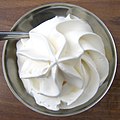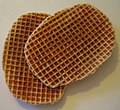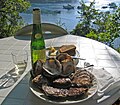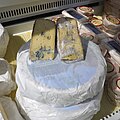
A | B | C | D | E | F | G | H | CH | I | J | K | L | M | N | O | P | Q | R | S | T | U | V | W | X | Y | Z | 0 | 1 | 2 | 3 | 4 | 5 | 6 | 7 | 8 | 9
This article needs additional citations for verification. (February 2023) |
| Part of a series on the |
| Culture of France |
|---|
| People |
| Mythology and folklore |
| Cuisine |
| Festivals |
| Religion |
| Music and performing arts |
| Sport |
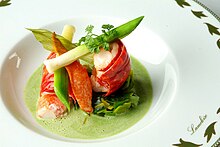
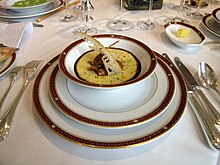
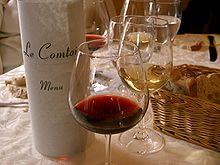
French cuisine is the cooking traditions and practices from France. In the 14th century, Guillaume Tirel, a court chef known as "Taillevent", wrote Le Viandier, one of the earliest recipe collections of medieval France. In the 17th century, chefs François Pierre La Varenne and Marie-Antoine Carême spearheaded movements that shifted French cooking away from its foreign influences and developed France's own indigenous style.
Cheese and wine are a major part of the cuisine. They play different roles regionally and nationally, with many variations and appellation d'origine contrôlée (AOC) (regulated appellation) laws.[1]
Culinary tourism and the Guide Michelin helped to acquaint commoners with the cuisine bourgeoise of the urban elites and the peasant cuisine of the French countryside starting in the 20th century. Many dishes that were once regional have proliferated in variations across the country.
Knowledge of French cooking has contributed significantly to Western cuisines. Its criteria are used widely in Western cookery school boards and culinary education. In November 2010, French gastronomy was added by the UNESCO to its lists of the world's "intangible cultural heritage".[2][3]
History
Middle Ages
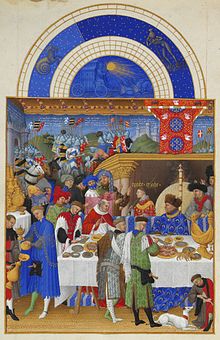
In French medieval cuisine, banquets were common among the aristocracy. Multiple courses would be prepared, but served in a style called service en confusion, or all at once. Food was generally eaten by hand, meats being sliced off in large pieces held between the thumb and two fingers. The sauces were highly seasoned and thick, and heavily flavored mustards were used.
Pies were a common banquet item, with the crust serving primarily as a container, rather than as food itself, and it was not until the very end of the Late Middle Ages that the shortcrust pie was developed.
Meals often ended with an issue de table, which later changed into the modern dessert, and typically consisted of dragées (in the Middle Ages, meaning spiced lumps of hardened sugar or honey), aged cheese, and spiced wine, such as hypocras.[4]: 1–7
The ingredients of the time varied greatly according to the seasons and the church calendar, and many items were preserved with salt, spices, honey, and other preservatives. Late spring, summer, and autumn afforded abundance, while winter meals were more sparse. Livestock were slaughtered at the beginning of winter. Beef was often salted, while pork was salted and smoked. Bacon and sausages would be smoked in the chimney, while the tongue and hams were brined and dried. Cucumbers were brined as well, while greens would be packed in jars with salt. Fruits, nuts and root vegetables would be boiled in honey for preservation. Whale, dolphin and porpoise were considered fish, so during Lent, the salted meats of these sea mammals were eaten.[4]: 9–12
Artificial freshwater ponds (often called stews) held carp, pike, tench, bream, eel, and other fish. Poultry was kept in special yards, with pigeon and squab being reserved for the elite. Game was highly prized, but very rare, and included venison, boar, hare, rabbit, and fowl.
Kitchen gardens provided herbs, including some, such as tansy, rue, pennyroyal, and hyssop, which are rarely used today. Spices were treasured and very expensive at that time—they included pepper, cinnamon, cloves, nutmeg, and mace. Some spices used then, but no longer today in French cuisine are cubebs, long pepper (both from vines similar to black pepper), grains of paradise, and galengale.
Sweet-sour flavors were commonly added to dishes with vinegar and verjus combined with sugar (for the affluent) or honey. A common form of food preparation was to thoroughly cook, pound, and strain mixtures into fine pastes and mushes, something believed to be beneficial to make use of nutrients.[4]: 13–15
Visual display was prized. Brilliant colors were obtained by the addition of, for example, juices from spinach and the green part of leeks. Yellow came from saffron or egg yolk, while red came from sunflower, and purple came from Crozophora tinctoria or Heliotropium europaeum.
Gold and silver leaf were placed on food surfaces and brushed with egg whites. Elaborate and showy dishes were the result, such as tourte parmerienne which was a pastry dish made to look like a castle with chicken-drumstick turrets coated with gold leaf. One of the grandest showpieces of the time was a roast swan or peacock sewn back into its skin with feathers intact, the feet and beak being gilded. Since both birds are stringy, and taste unpleasant, the skin and feathers could be kept and filled with the cooked, minced and seasoned flesh of tastier birds, like goose or chicken.[4]: 15–16
The most well-known French chef of the Middle Ages was Guillaume Tirel, also known as Taillevent. Taillevent worked in numerous royal kitchens during the 14th century. His first position was as a kitchen boy in 1326. He was chef to Philip VI, then the Dauphin who was son of John II. The Dauphin became King Charles V of France in 1364, with Taillevent as his chief cook. His career spanned sixty-six years, and upon his death, he was buried in grand style between his two wives. His tombstone represents him in armor, holding a shield with three cooking pots, marmites, on it.[4]: 18–21
Ancien Régime
Paris was the central hub of culture and economic activity, and as such, the most highly skilled culinary craftsmen were to be found there. Markets in Paris such as Les Halles, la Mégisserie, those found along Rue Mouffetard, and similar smaller versions in other cities were very important to the distribution of food. Those that gave French produce its characteristic identity were regulated by the guild system, which developed in the Middle Ages. In Paris, the guilds were regulated by city government as well as by the French crown. A guild restricted those in a given branch of the culinary industry to operate only within that field.[4]: 71–72
There were two groups of guilds—first, those that supplied the raw materials: butchers, fishmongers, grain merchants, and gardeners. The second group were those that supplied prepared foods: bakers, pastry cooks, sauce makers, poulterers, and caterers. Some guilds offered both raw materials and prepared food, such as the charcutiers and rôtisseurs (purveyors of roasted meat dishes). They would supply cooked meat pies and dishes as well as raw meat and poultry. This caused issues with butchers and poulterers, who sold the same raw materials.[4]: 72–73
The guilds served as a training ground for those within the industry. The degrees of assistant cook, full-fledged cook and master chef were conferred. Those who reached the level of master chef were of considerable rank in their individual industry, and enjoyed a high level of income as well as economic and job security. At times, those in the royal kitchens did fall under the guild hierarchy, but it was necessary to find them a parallel appointment based on their skills after leaving the service of the royal kitchens. This was not uncommon as the Paris cooks' Guild regulations allowed for this movement.[4]: 73
During the 16th and 17th centuries, French cuisine assimilated many new food items from the New World. Although they were slow to be adopted, records of banquets show Catherine de' Medici (1519–1589?) serving sixty-six turkeys at one dinner.[4]: 81 The dish called cassoulet has its roots in the New World discovery of haricot beans, which are central to the dish's creation, but had not existed outside of the Americas until the arrival of Europeans.[4]: 85
Haute cuisine (pronounced [ot kɥizin], "high cuisine") has foundations during the 17th century with a chef named La Varenne. As an author of works such as Le Cuisinier françois, he is credited with publishing the first true French cookbook. His book includes the earliest known reference to roux using pork fat. The book contained two sections, one for meat days, and one for fasting. His recipes marked a change from the style of cookery known in the Middle Ages to new techniques aimed at creating somewhat lighter dishes, and more modest presentations of pies as individual pastries and turnovers. La Varenne also published a book on pastry in 1667 entitled Le Parfait confitvrier (republished as Le Confiturier françois) which similarly updated and codified the emerging haute cuisine standards for desserts and pastries.[4]: 114–120
Chef François Massialot wrote Le Cuisinier roïal et bourgeois in 1691, during the reign of Louis XIV. The book contains menus served to the royal courts in 1690. Massialot worked mostly as a freelance cook, and was not employed by any particular household. Massialot and many other royal cooks received special privileges by association with the French royalty. They were not subject to the regulation of the guilds; therefore, they could cater weddings and banquets without restriction. His book is the first to list recipes alphabetically, perhaps a forerunner of the first culinary dictionary. It is in this book that a marinade is first seen in print, with one type for poultry and feathered game, while a second is for fish and shellfish. No quantities are listed in the recipes, which suggests that Massialot was writing for trained cooks.[4]: 149–154
The successive updates of Le Cuisinier roïal et bourgeois include important refinements such as adding a glass of wine to fish stock. Definitions were also added to the 1703 edition. The 1712 edition, retitled Le Nouveau cuisinier royal et bourgeois, was increased to two volumes, and was written in a more elaborate style with extensive explanations of technique. Additional smaller preparations are included in this edition as well, leading to lighter preparations, and adding a third course to the meal. Ragout, a stew still central to French cookery, makes its first appearance as a single dish in this edition as well; prior to that, it was listed as a garnish.[4]: 155
Late 18th century – early 19th century

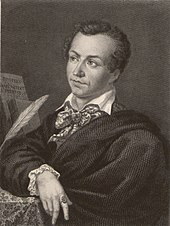
Shortly before the French Revolution, dishes like bouchées à la Reine gained prominence. Essentially royal cuisine produced by the royal household, this is a chicken-based recipe served on vol-au-vent created under the influence of Queen Marie Leszczyńska, the Polish-born wife of Louis XV. This recipe is still popular today, as are other recipes from Queen Marie Leszczyńska like consommé à la Reine and filet d'aloyau braisé à la royale. Queen Marie is also credited with introducing Polonaise garnishing to the French diet.
The French Revolution was integral to the expansion of French cuisine, because it abolished the guild system. This meant anyone could now produce and sell any culinary item they wished.
Bread was a significant food source among peasants and the working class in the late 18th century, with many of the nation's people being dependent on it. In French provinces, bread was often consumed three times a day by the people of France.[5] According to Brace, bread was referred to as the basic dietary item for the masses, and it was also used as a foundation for soup. In fact, bread was so important that harvest, interruption of commerce by wars, heavy flour exploration, and prices and supply were all watched and controlled by the French Government. Among the underprivileged, constant fear of famine was always prevalent. From 1725 to 1789, there were fourteen years of bad yields to blame for the low grain supply. In Bordeaux, during 1708–1789, thirty-three bad harvests occurred.[5]
Marie-Antoine Carême was born in 1784, five years before the Revolution. He spent his younger years working at a pâtisserie until he was discovered by Charles Maurice de Talleyrand-Périgord; he would later cook for Napoleon Bonaparte. Prior to his employment with Talleyrand, Carême had become known for his pièces montées, which were extravagant constructions of pastry and sugar architecture.[6]: 144–145
More important to Carême's career was his contribution to the refinement of French cuisine. The basis for his style of cooking was his sauces, which he named mother sauces. Often referred to as fonds, meaning "foundations", these base sauces, espagnole, velouté, and béchamel, are still known today. Each of these sauces was made in large quantities in his kitchen, then formed the basis of multiple derivatives. Carême had over one hundred sauces in his repertoire.
In his writings, soufflés appear for the first time. Although many of his preparations today seem extravagant, he simplified and codified an even more complex cuisine that existed beforehand. Central to his codification of the cuisine were Le Maître d'hôtel français (1822), Le Cuisinier parisien (1828) and L'Art de la cuisine française au dix-neuvième siècle (1833–5).[6]: 144–148
Late 19th century – early 20th century

Georges Auguste Escoffier is commonly acknowledged as the central figure to the modernization of haute cuisine and organizing what would become the national cuisine of France. His influence began with the rise of some of the great hotels in Europe and America during the 1880s-1890s. The Savoy Hotel managed by César Ritz was an early hotel in which Escoffier worked, but much of his influence came during his management of the kitchens in the Carlton from 1898 until 1921. He created a system of "parties" called the brigade system, which separated the professional kitchen into five separate stations.
These five stations included the garde manger that prepared cold dishes; the entremettier prepared starches and vegetables, the rôtisseur prepared roasts, grilled and fried dishes; the saucier prepared sauces and soups; and the pâtissier prepared all pastry and desserts items.
This system meant that instead of one person preparing a dish on one's own, now multiple cooks would prepare the different components for the dish. An example used is oeufs au plat Meyerbeer, the prior system would take up to fifteen minutes to prepare the dish, while in the new system, the eggs would be prepared by the entremettier, kidney grilled by the rôtisseur, truffle sauce made by the saucier and thus the dish could be prepared in a shorter time and served quickly in the popular restaurants.[6]: 157–159
Escoffier also simplified and organized the modern menu and structure of the meal. He published a series of articles in professional journals which outlined the sequence, and he finally published his Livre des menus in 1912. This type of service embraced the service à la russe (serving meals in separate courses on individual plates), which Félix Urbain Dubois had made popular in the 1860s. Escoffier's largest contribution was the publication of Le Guide Culinaire in 1903, which established the fundamentals of French cookery. The book was a collaboration with Philéas Gilbert, E. Fetu, A. Suzanne, B. Reboul, Ch. Dietrich, A. Caillat and others. The significance of this is to illustrate the universal acceptance by multiple high-profile chefs to this new style of cooking.[6]: 159–160
Le Guide Culinaire deemphasized the use of heavy sauces and leaned toward lighter fumets, which are the essence of flavor taken from fish, meat and vegetables. This style of cooking looked to create garnishes and sauces whose function is to add to the flavor of the dish, rather than mask flavors like the heavy sauces and ornate garnishes of the past. Escoffier took inspiration for his work from personal recipes in addition to recipes from Carême, Dubois and ideas from Taillevent's Le Viandier, which had a modern version published in 1897. A second source for recipes came from existing peasant dishes that were translated into the refined techniques of haute cuisine.
Expensive ingredients would replace the common ingredients, making the dishes much less humble. The third source of recipes was Escoffier himself, who invented many new dishes, such as pêche Melba.[6]: 160–162 Escoffier updated Le Guide Culinaire four times during his lifetime, noting in the foreword to the book's first edition that even with its 5,000 recipes, the book should not be considered an "exhaustive" text, and that even if it were at the point when he wrote the book, "it would no longer be so tomorrow, because progress marches on each day."[7]
This period is also marked by the appearance of the nouvelle cuisine. The term "nouvelle cuisine" has been used many times in the history of French cuisine which emphasized the freshness, lightness and clarity of flavor and inspired by new movements in world cuisine. In the 1740s, Menon first used the term, but the cooking of Vincent La Chapelle and François Marin was also considered modern. In the 1960s, Henri Gault and Christian Millau revived it to describe the cooking of Paul Bocuse, Jean and Pierre Troisgros, Michel Guérard, Roger Vergé and Raymond Oliver.[8] These chefs were working toward rebelling against the "orthodoxy" of Escoffier's cuisine. Some of the chefs were students of Fernand Point at the Pyramide in Vienne, and had left to open their own restaurants. Gault and Millau "discovered the formula" contained in ten characteristics of this new style of cooking.[6]: 163–164
The characteristics that emerged during this period were:
1. A rejection of excessive complication in cooking.
2. The cooking times for most fish, seafood, game birds, veal, green vegetables and pâtés was greatly reduced in an attempt to preserve the natural flavors. Steaming was an important trend from this characteristic.
3. The cuisine was made with the freshest possible ingredients.
4. Large menus were abandoned in favor of shorter menus.
5. Strong marinades for meat and game ceased to be used.[6]: 163–164
6. They stopped using heavy sauces such as espagnole and béchamel thickened with flour based "roux" in favor of seasoning their dishes with fresh herbs, quality butter, lemon juice, and vinegar.
7. They used regional dishes for inspiration instead of haute cuisine dishes.
8. New techniques were embraced and modern equipment was often used; Bocuse even used microwave ovens.
9. The chefs paid close attention to the dietary needs of their guests through their dishes.
10. And finally, the chefs were extremely inventive and created new combinations and pairings.[6]: 163–164
Some have speculated that a contributor to nouvelle cuisine was World War II when animal protein was in short supply during the German occupation.[9] By the mid-1980s food writers stated that the style of cuisine had reached exhaustion and many chefs began returning to the haute cuisine style of cooking, although much of the lighter presentations and new techniques remained.[6]: 163–164
When the French colonized Vietnam, one of the most famous and popular dishes, pot-au-feu, was subsequently introduced to the local people. While it did not directly create the widely recognizable Vietnamese dish, Pho, it served as a reference for the modern-day form of Pho.
National cuisine
There are many dishes that are considered part of French national cuisine today.
A meal often consists of three courses, hors d'œuvre or entrée (introductory course, sometimes soup), plat principal (main course), fromage (cheese course) or dessert, sometimes with a salad offered before the cheese or dessert.
- Hors d'œuvre
-
Basil salmon terrine
- Plat principal
-
Pot-au-feu is a cuisine classique dish.
-
Steak frites is a simple and popular dish.
- Pâtisserie
-
Typical French pâtisserie
- Dessert
Regional cuisine
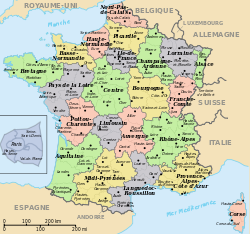
French regional cuisine is characterized by its extreme diversity and style. Traditionally, each region of France has its own distinctive cuisine.[10]
Paris and Île-de-France
Paris and Île-de-France are central regions where almost anything from the country is available, as all train lines meet in the city. Over 9,000 restaurants exist in Paris and almost any cuisine can be obtained here. High-quality Michelin Guide-rated restaurants proliferate here.[11]
Champagne, Lorraine, and Alsace
Game and ham are popular in Champagne, as well as the special sparkling wine simply known as Champagne. Fine fruit preserves are known from Lorraine as well as the quiche Lorraine.[12] As region of historically Allemanic German culture Alsace has retained Elements of German cuisine, especially similar to those from the neighboring Palatinate and Baden region, but has implemented French influences since France first took control of the region in the 17th century. As such, beers made in the area are similar to the style of bordering Germany. Dishes like choucroute (French for sauerkraut) are also popular.[11]: 55 Many "eaux de vie" (distilled alcohol from fruit) also called schnaps are from this region, due to a wide variety of local fruits (cherry, raspberry, pear, grapes) and especially prunes (mirabelle, plum).:259,295[clarification needed]
-
Alsatian Flammekueche

Nord Pas-de-Calais, Picardy, Normandy, and Brittany
The coastline supplies many crustaceans, sea bass, monkfish and herring. Normandy has top-quality seafood, such as scallops and sole, while Brittany has a supply of lobster, crayfish and mussels.
Normandy is home to a large population of apple trees; apples are often used in dishes, as well as cider and Calvados. The northern areas of this region, especially Nord, grow ample amounts of wheat, sugar beets and chicory. Thick stews are found often in these northern areas as well.
The produce of these northern regions is also considered some of the best in the country, including cauliflower and artichokes. Buckwheat grows widely in Brittany as well and is used in the region's galettes, called jalet, which is where this dish originated.[11]: 93
-
Crème Chantilly, created at the Château de Chantilly.
Loire Valley and central France
High-quality fruits come from the Loire Valley and central France, including cherries grown for the liqueur Guignolet and Belle Angevine pears. The strawberries and melons are also of high quality.
Fish are seen in the cuisine, often served with a beurre blanc sauce, as well as wild game, lamb, calves, Charolais cattle, Géline fowl, and goat cheeses.
Young vegetables are used often, as are the specialty mushrooms of the region, champignons de Paris. Vinegars from Orléans are a specialty ingredient used as well.[11]: 129, 132
Burgundy and Franche-Comté
Burgundy and Franche-Comté are known for their wines. Pike, perch, river crabs, snails, game, redcurrants, blackcurrants are from both Burgundy and Franche-Comté.
Savory specialties accounted in the Cuisine franc-comtoise from the Franche-Comté region are croûte aux morilles, Poulet à la Comtoise, trout, smoked meats and cheeses such as Mont d'Or, Comté and Morbier which are best eaten hot or cold, coq au vin jaune and the special dessert gâteau de ménage.
Charolais beef, poultry from Bresse, sea snail, honey cake, Chaource and Époisses cheese are specialties of the local cuisine of Burgundy. Dijon mustard is also a specialty of Burgundy cuisine. Crème de cassis is a popular liquor made from blackcurrants. Oils are used in the cooking here, including nut oils and rapeseed oil.[11]: 153, 156, 166, 185
-
Escargots, with special tongs and fork
-
Beaujolais wine
-
Gâteau de ménage
Auvergne-Rhône-Alpes

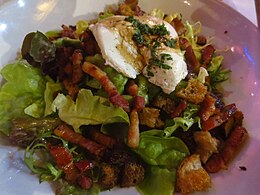


The area covers the old province of Dauphiné, once known as the "larder" of France,[dubious – discuss] that gave its name to gratin dauphinois,[13] traditionally made in a large baking dish rubbed with garlic. Successive layers of potatoes, salt, pepper and milk are piled up to the top of the dish. It is then baked in the oven at low temperature for 2 hours.[14]
Fruit and young vegetables are popular in the cuisine from the Rhône valley, as are wines like Hermitage AOC, Crozes-Hermitage AOC and Condrieu AOC. Walnuts and walnut products and oil from Noix de Grenoble AOC, lowland cheeses, like St. Marcellin, St. Félicien and Bleu du Vercors-Sassenage.
Poultry from Bresse, guinea fowl from Drôme and fish from the Dombes, a light yeast-based cake, called Pogne de Romans and the regional speciality, Raviole du Dauphiné, and there is the short-crust "Suisse", a Valence biscuit speciality.
Lakes and mountain streams in Rhône-Alpes are key to the cuisine as well. Lyon and Savoy supply sausages while the Alpine regions supply their specialty cheeses like Beaufort, Abondance, Reblochon, Tomme and Vacherin.[15][16][17][18]
Mères lyonnaises are female cooks particular to this region who provide local gourmet establishments.[19] Celebrated chefs from this region include Fernand Point, Paul Bocuse, the Troisgros brothers and Alain Chapel.[20]
The Chartreuse Mountains are the source of the green and yellow digestif liquor Chartreuse, produced by the monks of the Grande Chartreuse.[11]: 197, 230
Since the 2014 administrative reform, the ancient area of Auvergne is now part of the region. One of its leading chefs is Regis Marcon.
-
Condrieu wine
-
Poulet de Bresse chicken salad
-
Noix de Grenoble, unusual trilaterally symmetric walnut
-
Beaufort cheeses ripening in a cellar
Poitou-Charentes and Limousin
Zdroj:https://en.wikipedia.org?pojem=French_restaurantText je dostupný za podmienok Creative Commons Attribution/Share-Alike License 3.0 Unported; prípadne za ďalších podmienok. Podrobnejšie informácie nájdete na stránke Podmienky použitia.
Antropológia
Aplikované vedy
Bibliometria
Dejiny vedy
Encyklopédie
Filozofia vedy
Forenzné vedy
Humanitné vedy
Knižničná veda
Kryogenika
Kryptológia
Kulturológia
Literárna veda
Medzidisciplinárne oblasti
Metódy kvantitatívnej analýzy
Metavedy
Metodika
Text je dostupný za podmienok Creative
Commons Attribution/Share-Alike License 3.0 Unported; prípadne za ďalších
podmienok.
Podrobnejšie informácie nájdete na stránke Podmienky
použitia.
www.astronomia.sk | www.biologia.sk | www.botanika.sk | www.dejiny.sk | www.economy.sk | www.elektrotechnika.sk | www.estetika.sk | www.farmakologia.sk | www.filozofia.sk | Fyzika | www.futurologia.sk | www.genetika.sk | www.chemia.sk | www.lingvistika.sk | www.politologia.sk | www.psychologia.sk | www.sexuologia.sk | www.sociologia.sk | www.veda.sk I www.zoologia.sk





















